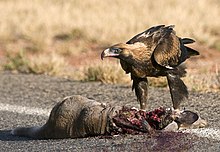Aquila audax
Wedge-tailed Eagle has long wings (wingspan 2.3 m), a characteristic long, wedge-shaped tail, and legs that are feathered all the way to the base of the toes. The bill is pale pink to cream, the eye brown to dark brown, and the feet off-white. Young Wedge-tailed Eagles are mid brown in colour with reddish-brown heads and wings. They become progressively blacker for at least the first ten years of their lives; adults are mostly dark blackish-brown. The only difference in plumage between the sexes is that a female adult is generally slightly paler than her mate. Females (4.2 kg - 5.3 kg) are also larger and heavier than males (3.2 kg up to 4.0 kg). Wedge-tailed Eagles are Australia's largest raptors (birds of prey).
Not Threatened.
Wedge-tailed Eagle has long wings (wingspan 2.3 m), a characteristic long, wedge-shaped tail, and legs that are feathered all the way to the base of the toes. The bill is pale pink to cream, the eye brown to dark brown, and the feet off-white. Young Wedge-tailed Eagles are mid brown in colour with reddish-brown heads and wings. They become progressively blacker for at least the first ten years of their lives; adults are mostly dark blackish-brown. The only difference in plumage between the sexes is that a female adult is generally slightly paler than her mate. Females (4.2 kg - 5.3 kg) are also larger and heavier than males (3.2 kg up to 4.0 kg). Wedge-tailed Eagles are Australia's largest raptors (birds of prey).
87-105 cm, 4025 g
Taxonomy:
- Vultur audax Latham, 1801, New South Wales. Formerly placed in monospecific genus Uroaetus, but clearly related to other Aquila. Has been considered to form superspecies with A.chrysaetos, and possibly also with A. gurneyi. Two subspecies recognized. (source: Handbook of the Birds of World)
Subspecies and Distribution:
- * audax (Latham, 1801) - Australia, S New Guinea. * fleayi Condon & Amadon, 1954 - Tasmania.
is found from sea level to alpine regions in the mountains, but prefers wooded and forested land and open country, generally avoiding rainforest and coastal heaths. Eagles can be seen perched on trees or poles or soaring overhead to altitudes of up to 2000 m. Wedge-tailed Eagles build their nest in a prominent location with a good view of the surrounding countryside. It may be built in either a live or dead tree, but usually the tallest one in the territory. In some parts of Australia, where tall trees are absent, small trees, shrubs, cliff faces or even the ground may be used. The density of active nests depends on the abundance of prey and other resources. In most years, nests are usually 2.5 km - 4 km apart. If conditions are particularly good, the distances apart may be less than 1 km because the birds require smaller areas to find sufficient food.
eat both live prey and carrion. Their diet reflects the available prey, but the most important live items are rabbits and hares. Rabbits usually comprise about 30-70% of the diet, but may comprise up to 92%. The introduction of the calicivirus has resulted in the decline of rabbits in many parts of Australia. It is not yet known how this will affect the Wedge-tailed Eagle. Other food items include lizards, birds (weighing over 100 g) and mammals (usually weighing over 500 g). Wedge-tailed Eagles will kill lambs, but these make up only a small percentage of their total prey. Carrion is a major food source; roadkills and other carcasses are readily eaten. Many of the reports of predation on lambs result from birds scavenging already dead animals. Up to 20 birds may attend a carcass, although only two or three feed at any one time. Wedge-tailed Eagles may hunt singly, in pairs or in larger groups. Working together, a group of eagles can attack and kill animals as large as adult kangaroos. This explains the scientific name of the Wedge-tailed Eagle which means 'bold eagle'. Under ideal conditions, an eagle can lift about 50% of its body weight. Often, eagles may cache food items on a branch near the nest area.
The timing of breeding may vary from location to location and from year to year according to the local availability of food. Both parents share in the duties of nest building, incubation and feeding of the young. A clutch consists of white eggs measuring 73 mm x 59 mm with varying amounts of reddish brown spots and blotches. These are laid at intervals of two to four days. Incubation starts with the laying of the first egg. Because of the intervals between laying, the eggs do not hatch simultaneously. The first chick hatches larger than the second, which in turn is larger than the third. Survival rates of the chicks vary considerably depending on local conditions, including prey abundance and the amount of disturbance. A breeding pair usually rears only one young per clutch, although in a good year, two chicks may fledge in some nests. Because of the differences in size, the oldest and largest chick has the best chance of surviving. If food is scarce, it will kill and eat its smaller nest mates










